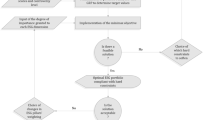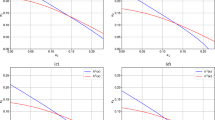Abstract
We establish new conditions under which a constrained (no short-selling) time-consistent equilibrium strategy, starting at a certain time, will beat the unconstrained counterpart, as measured by the magnitude of their corresponding equilibrium mean–variance value functions. We further show that the pure strategy of solely investing in a risk-free bond can sometimes simultaneously dominate both constrained and unconstrained equilibrium strategies. With numerical experiments, we also illustrate that the constrained strategy can dominate the unconstrained one for most of the commencement dates (even more than 90%) of a prescribed planning horizon. Under a precommitment approach, the value function of an investor increases with the size of the admissible sets of strategies. However, this may fail to be true under the game-theoretic paradigm, as the constraint of time-consistency itself affects the value function differently when short-selling is and is not prohibited.




Similar content being viewed by others
Notes
It is reasonable to assume an increasing function of \(\gamma_{t}\) since people usually look for a more stable income as they get older, so they become more risk-averse, relative to their current wealth, as time evolves.
References
Basak, S., Chabakauri, G.: Dynamic mean–variance asset allocation. Rev. Financ. Stud. 23, 2970–3016 (2010)
Bellman, R.E.: Dynamic Programming. Princeton University Press, Princeton (1957)
Bensoussan, A., Wong, K.C., Yam, S.C.P., Yung, S.P.: Time-consistent portfolio selection under short-selling prohibition: from discrete to continuous setting. SIAM J. Financ. Math. 5, 153–190 (2014)
Björk, T., Khapko, M., Murgoci, A.: Time inconsistent stochastic control in continuous time: theory and examples. Working Paper (2016). Available online at arXiv:1612.03650
Björk, T., Murgoci, A.: A theory of Markovian time inconsistent stochastic control in discrete time. Finance Stoch. 18, 545–592 (2014)
Björk, T., Murgoci, A., Zhou, X.Y.: Mean–variance portfolio optimization with state-dependent risk aversion. Math. Finance 24, 1–24 (2014)
Cui, X.Y., Li, D., Shi, Y.: Self-coordination in time inconsistent stochastic decision problems: a planner-doer game framework. J. Econ. Dyn. Control 75, 91–113 (2017)
Czichowsky, C.: Time-consistent mean–variance portfolio selection in discrete and continuous time. Finance Stoch. 17, 227–271 (2013)
Ekeland, I., Mbodj, O., Pirvu, T.A.: Time-consistent portfolio management. SIAM J. Financ. Math. 3, 1–32 (2012)
Ekeland, I., Pirvu, T.A.: Investment and consumption without commitment. Math. Financ. Econ. 2, 57–86 (2008)
Forsyth, P.A., Wang, J.: Continuous time mean variance asset allocation: a time-consistent strategy. Eur. J. Oper. Res. 209, 184–201 (2011)
Harris, C., Laibson, D.: Instantaneous gratification. Q. J. Econ. 128, 205–248 (2013)
Karp, L.S.: Non-constant discounting in continuous time. J. Econ. Theory 132, 557–568 (2007)
Kronborg, M.T., Steffensen, M.: Inconsistent investment and consumption problems. Appl. Math. Optim. 71, 473–515 (2015)
Li, D., Zhou, X.Y.: Continuous-time mean–variance portfolio selection: a stochastic LQ framework. Appl. Math. Optim. 42, 19–33 (2000)
Marín-Solano, J., Navas, J.: Consumption and portfolio rules for time-inconsistent investors. Eur. J. Oper. Res. 201, 860–872 (2010)
Markowitz, H.: Portfolio selection. J. Finance 7, 77–91 (1952)
Pedersen, J.L., Peskir, G.: Optimal mean–variance portfolio selection. Math. Financ. Econ. 11, 137–160 (2017)
Phelps, E.S., Pollak, R.A.: On second-best national saving and game-equilibrium growth. Rev. Econ. Stud. 35, 185–199 (1968)
Pollak, R.A.: Consistent planning. Rev. Econ. Stud. 35, 201–208 (1968)
Peleg, B., Yaari, M.E.: On the existence of a consistent course of action when tastes are changing. Rev. Econ. Stud. 40, 391–401 (1973)
Schweizer, M.: Mean–variance hedging. In: Cont, R. (ed.) Encyclopedia of Quantitative Finance, pp. 1177–1181. Wiley, New York (2010)
Strotz, R.H.: Myopia and inconsistency in dynamic utility maximization. Rev. Econ. Stud. 23, 165–180 (1955)
Vigna, E.: Tail optimality and preferences consistency for intertemporal optimization problems. Working Paper, Collegio Carlo Alberto 502 (2017). Available online at https://www.carloalberto.org/assets/working-papers/no.502.pdf
Acknowledgements
We are very grateful to various participants for their valuable discussions and comments after the talks based on the present work. We thank our colleague John Wright for his suggestions on enriching the presentation of our paper. We express our sincere gratitude to the editors and anonymous referees for their very useful suggestions and inspiring comments which much enhanced our article. The first author acknowledges the financial support from the National Science Foundation under grant DMS-1612880, and the Research Grant Council of Hong Kong Special Administrative Region under grant GRF 11303316. The second author acknowledges the financial support from ERC (279582) and SFI (16/IA/4443,16/SPP/3347), and the present work constitutes a part of his work for his postgraduate dissertation. The third author acknowledges the financial support from HKGRF-14300717 with the project title: New Kinds of Forward–Backward Stochastic Systems with Applications, HKSAR-GRF-14301015 with title: Advance in Mean Field Theory, Direct Grant for Research 2014/15 with project code: 4053141 offered by CUHK. He also thanks Columbia University for the kind invitation to be a visiting faculty member in the Department of Statistics during his sabbatical leave. The third author also recalls the unforgettable moments and the happiness shared with his beloved father during the drafting of the present article at their home. Although he just lost his father with the deepest sadness at the final stage of the review of this work, his father will never leave the heart of Phillip Yam; and he used this work in memory of his father’s brave battle against liver cancer.
Author information
Authors and Affiliations
Corresponding author
Additional information
Publisher’s Note
Springer Nature remains neutral with regard to jurisdictional claims in published maps and institutional affiliations.
Appendix: Technical proofs in Sect. 4
Appendix: Technical proofs in Sect. 4
1.1 A.1 Proof of Theorem 4.1
Recall (1.7) and (1.9). Then (4.1) implies \(c^{(U)}_{T}=c^{(C)}_{T}<1\). Because we have \(G(x)=x\) when \(x\in(0,1)\) (see Theorem 1.6), we get for any \(t\) with \(c^{(C)}_{t} \in(0,1)\) that \(c^{(C)}_{t}=G(\frac{\alpha_{t}}{\sigma^{2}_{t}} d^{(C)}_{t})=\frac{\alpha_{t}}{\sigma^{2}_{t}} d^{(C)}_{t}\) by (1.9). Thus both \(c^{(C)}_{\cdot}\) and \(c^{(U)}_{\cdot}\) satisfy the same form of integral equations (see (1.7) and (1.9)) over \([t,T]\). Therefore, \(c^{(U)}_{t}=c^{(C)}_{t} \in(0,1)\) for any \(t>\sup\{t< T: c^{(C)}_{t} \notin(0,1) \}\). By Lemmas 3.1 (i) and 3.5 (i), (4.2) implies that both \(c^{(U)}\) and \(c^{(C)}\) are increasing in \(t\) whenever \(c^{(U)}_{t}=c^{(C)}_{t}>0\). Define
We consider two separate cases:
(i) If \(\tau^{*}_{0}=-\infty\), then \(c^{(U)}_{t}=c^{(C)}_{t} \in(0,1)\) for all \(t\leq T\) and it is clear that \(V^{(U)}(t,x)= V^{(C)}(t,x)\) for all \(t \leq T\) and \(x>0\).
(ii) If \(\tau^{*}_{0}>-\infty\), we have \(c^{(U)}_{t}=c^{(C)}_{t} \in(0,1)\) for all \(t \in(\tau^{*}_{0},T)\) and \(c^{(U)}_{t} \leq c^{(C)}_{t}=0\) for all \(t <\tau^{*}_{0}\) because of Lemmas 3.1 (i) and 3.5 (i). Therefore, we obtain \(V^{(U)}(t,x)= V^{(C)}(t,x)\) for all \(t \in[\tau^{*}_{0},T]\) and \(x>0\). Recall that the equilibrium value function in terms of the investment-to-wealth ratio \(c\) is
Differentiating the product \(e^{-\int^{T}_{t} r_{s} ds} V(t,x)\) gives
We can then deduce that for any \(t < \tau^{*}_{0}\) and \(x>0\),
where the first equality follows because \(c^{(C)}_{t}=0\) for \(t <\tau^{*}_{0}\), \(c^{(C)}_{t}=c^{(U)}_{t}\) for \(t \in[\tau^{*}_{0},T]\) and \(c^{(U)}_{t}\) satisfies (1.7). Next we compute
for \(t<\tau^{*}_{0}\), where the second equality follows from (1.7), and the positivity from the fact that \(c^{(U)}_{t} \leq0\) for \(t<\tau^{*}_{0}\). Hence we have
for \(t<\tau^{*}_{0}\). Together with the result in (4.2), the inequality (A.2) thus becomes
Since \(V^{(U)}(\tau^{*}_{0},x)=V^{(C)}(\tau^{*}_{0},x)\), we have for \(t<\tau ^{*}_{0}\) and \(x>0\) that
and so the claim follows. □
1.2 A.2 Proof of Theorem 4.3
We only prove the constrained case and omit the unconstrained one as its argument is analogous. Using the differentiation in (A.1), we have for \(t \leq T\) and \(x>0\) that
where the first inequality follows from (4.3). On the other hand, (1.9) gives
whenever \(c^{(C)}_{t} \geq0\). Thus (A.3) now becomes
Hence
and our claim is justified for the constrained case. □
Rights and permissions
About this article
Cite this article
Bensoussan, A., Wong, K.C. & Yam, S.C.P. A paradox in time-consistency in the mean–variance problem?. Finance Stoch 23, 173–207 (2019). https://doi.org/10.1007/s00780-018-00381-0
Received:
Accepted:
Published:
Issue Date:
DOI: https://doi.org/10.1007/s00780-018-00381-0
Keywords
- Time-consistency
- Mean–variance
- State-dependent risk-aversion
- Equilibrium strategy
- Short-selling prohibition




